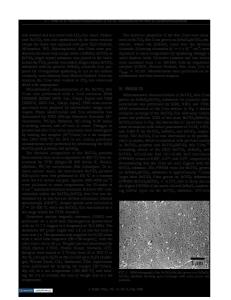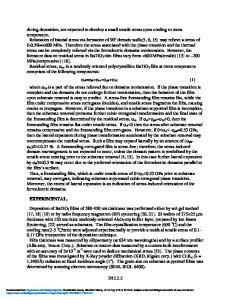Phase stability of heteroepitaxial polydomain BaTiO 3 thin films
- PDF / 227,342 Bytes
- 6 Pages / 585 x 783 pts Page_size
- 24 Downloads / 393 Views
A.Y. Desai Department of Materials Science and Engineering and Materials Research Center, Northwestern University, Evanston, Illinois 60208; and Department of Materials Science and Engineering, North Carolina State University, Raleigh, North Carolina 27695
L. Wang and T.J. Marks Department of Chemistry and Materials Research Center, Northwestern University, Evanston, Illinois 60208
B.W. Wesselsa) Department of Materials Science and Engineering and Materials Research Center, Northwestern University, Evanston, Illinois 60208; and Department of Electrical and Computer Engineering, Northwestern University, Evanston, Illinois 60208 (Received 11 August 2006; accepted 13 February 2007)
The phase stability of ferroelectric, epitaxial, polydomain BaTiO3 thin films was examined using temperature-dependent x-ray diffraction (XRD) and in-plane electronic polarization measurements. The epitaxial BaTiO3 thin films were grown on MgO(100) substrates by a metal-organic chemical vapor deposition process. As-deposited and annealed BaTiO3 thin films with different domain structures were examined. Temperature-dependent plane-normal XRD analysis reveals well-defined phase transitions at 140 and 169 °C in the c- and a-oriented films, respectively. The measured Curie temperatures are consistent with those predicted by Landau-Ginsburg-Devonshire theory as applied to polydomain BaTiO3 thin films. Temperature-dependent in-plane electronic polarization measurements confirm that the 140 °C Curie temperature observed in the c-oriented film is a well-defined second-order paraelectric-ferroelectric transition. I. INTRODUCTION
BaTiO3 thin films are promising for use in nextgeneration microwave and optoelectronic devices, including electro-optic modulators1–4 and frequency doublers.5 For these applications, epitaxial films are preferred for optimal performance. The phase stability of epitaxial BaTiO3 thin films on a variety of substrates, including SrTiO3,6–10 MgO,11–16 and rare earth scandates,17 has been reported. The BaTiO3 films in these studies were grown using a variety of growth techniques, including sputtering, pulsed laser deposition, activated reactive evaporation, metal-organic chemical vapor deposition (MOCVD), and molecular beam epitaxy. Despite the large volume of theoretical and experimental work, the nature of the phase transitions in BaTiO3 films remains a subject of debate and active inquiry.
a)
Address all correspondence to this author. e-mail: [email protected] DOI: 10.1557/JMR.2007.0178 1384 J. Mater. Res., Vol. 22, No. 5, May 2007 http://journals.cambridge.org Downloaded: 17 Mar 2015
Although a first-order paraelectric-to-ferroelectric phase transition occurs at 130 °C in bulk BaTiO3, in thin films, this transition is generally observed to occur at higher temperatures ranging from 140–417 °C.6–16 This is consistent with the Landau-Ginsburg-Devonshire (LGD) theory, which predicts an elevated Curie temperature for compressive and tensile strain states. Furthermore, in BaTiO3 thin films, in contrast to the bulk ma
Data Loading...











